Charles Le Brun ist einer der wirkungsmächtigsten französischen Künstler. Der Maler, Bildhauer, Architekt und Ornamentenzeichner war der geistige Vater und die treibende Kraft hinter der Stil-Epoche, die wir heute als Louis XIV. bezeichnen. Die enorme breite seines kreativen Schaffens, er war nicht nur Maler und Bildhauer, sondern auch Innendekorateur, Stuckateur und Designer für Teppiche, Tapeten und Tapisserien, ermöglichte es ihm, der gesamten Kunst dieser Epoche seinen Stempel aufzudrücken. Sein Stil prägte die nachfolgenden Generationen höfischer Künstler und diente noch bis ins 18. Jahrhundert hinein als Referenzgröße und als idealisiertes Gegenstück zum ausbordenden Rokoko.
Le Bruns Karriere begann früh, im Alter von 13 Jahren, als eine von ihm verfertigte Zeichnung Ludwig III. zu Pferde die Aufmerksamkeit des damaligen Kanzlers Ségnier erweckte. Danach wurde das Talent des jungen Steinmetzlehrlings systematisch gefördert. 1619 in Paris geboren, war Le Bruns 1638 bereits Hofmaler und erhielt erste Aufträge von Kardinal Richelieu. Seine höfischen Gönner ermöglichten dem Künstler einen Italienaufenthalt, wo er seine Ausbildung vervollkommnete und unter anderem in Rom bei Nicolas Poussin studierte. In dieser Zeit widmete er sich auch den Arbeiten Carraccis, Raffael und Renis, die sein späteres Werk stark beeinflussten. So zum Beispiel eines der bekanntesten Werke Le Bruns, den Einzug Alexanders in Babylon, das heute im Louvre besichtigt werden kann.
×





_-_by_Lebrun_in_Treats_of_the_physiogno_-_(MeisterDrucke-1027229).jpg)
_-_by_Lebrun_in_Treats_of_the_physiogno_-_(MeisterDrucke-1027229).jpg)
.jpg)
.jpg)
_-_(MeisterDrucke-1425221).jpg)
_-_(MeisterDrucke-1425221).jpg)
.jpg)
.jpg)
_oil_on_canvas_-_(MeisterDrucke-1117626).jpg)
_oil_on_canvas_-_(MeisterDrucke-1117626).jpg)
.jpg)
.jpg)
_c1668_-_(MeisterDrucke-37982).jpg)
_c1668_-_(MeisterDrucke-37982).jpg)
.jpg)
.jpg)
.jpg)
.jpg)
.jpg)
.jpg)
.jpg)
.jpg)
.jpg)
.jpg)
.jpg)
.jpg)
 (pastel on paper) - (MeisterDrucke-79278).jpg)
 (pastel on paper) - (MeisterDrucke-79278).jpg)
.jpg)
.jpg)
.jpg)
.jpg)
.jpg)
.jpg)
.jpg)
.jpg)
.jpg)
.jpg)
.jpg)
.jpg)
.jpg)
.jpg)
.jpg)
.jpg)
.jpg)
.jpg)
.jpg)
.jpg)
.jpg)
.jpg)
_-_De_val_der_opstandige_engelen_-_(MeisterDrucke-1384816).jpg)
_-_De_val_der_opstandige_engelen_-_(MeisterDrucke-1384816).jpg)
_(1619-1690)_-_(MeisterDrucke-969780).jpg)
_(1619-1690)_-_(MeisterDrucke-969780).jpg)
 - (MeisterDrucke-169366).jpg)
 - (MeisterDrucke-169366).jpg)
.jpg)
.jpg)
.jpg)
.jpg)
 - (MeisterDrucke-111381).jpg)
 - (MeisterDrucke-111381).jpg)
.jpg)
.jpg)
_(detail_of_9_-_(MeisterDrucke-1425050).jpg)
_(detail_of_9_-_(MeisterDrucke-1425050).jpg)
.jpg)
.jpg)
 - (MeisterDrucke-92862).jpg)
 - (MeisterDrucke-92862).jpg)
.jpg)
.jpg)
.jpg)
.jpg)
.jpg)
.jpg)
 331 BC c1673 - (MeisterDrucke-169221).jpg)
 331 BC c1673 - (MeisterDrucke-169221).jpg)
.jpg)
.jpg)
 - (MeisterDrucke-274816).jpg)
 - (MeisterDrucke-274816).jpg)
.jpg)
.jpg)
.jpg)
.jpg)
.jpg)
.jpg)
.jpg)
.jpg)
_-_(MeisterDrucke-137724).jpg)
_-_(MeisterDrucke-137724).jpg)
.jpg)
.jpg)
 woven at the Atelier des Gobelins (wool tapestry) - (MeisterDrucke-131729).jpg)
 woven at the Atelier des Gobelins (wool tapestry) - (MeisterDrucke-131729).jpg)
.jpg)
.jpg)
 - (MeisterDrucke-98132).jpg)
 - (MeisterDrucke-98132).jpg)
.jpg)
.jpg)
 visiting the Gobelins factory 15th Oct - (MeisterDrucke-227681).jpg)
 visiting the Gobelins factory 15th Oct - (MeisterDrucke-227681).jpg)
.jpg)
.jpg)
.jpg)
.jpg)
 of Spain and Louis XIV (1638-1715) on the Island of Pheasants (tapestry) - (MeisterDrucke-188971).jpg)
 of Spain and Louis XIV (1638-1715) on the Island of Pheasants (tapestry) - (MeisterDrucke-188971).jpg)
.jpg)
.jpg)
_(1619-1690)_-_(MeisterDrucke-950890).jpg)
_(1619-1690)_-_(MeisterDrucke-950890).jpg)
.jpg)
.jpg)
.jpg)
.jpg)
_young_Artwork_by_Charles_Lebrun_(Le_Brun)_(1_-_(MeisterDrucke-1004651).jpg)
_young_Artwork_by_Charles_Lebrun_(Le_Brun)_(1_-_(MeisterDrucke-1004651).jpg)
.jpg)
.jpg)
_1653_-_(MeisterDrucke-122169).jpg)
_1653_-_(MeisterDrucke-122169).jpg)
.jpg)
.jpg)
 visiting the Gobelins factory 15th October 1667 (tapestry) - (MeisterDrucke-215736).jpg)
 visiting the Gobelins factory 15th October 1667 (tapestry) - (MeisterDrucke-215736).jpg)
_-_by_Le_brun_-_(MeisterDrucke-1027892).jpg)
_-_by_Le_brun_-_(MeisterDrucke-1027892).jpg)
 with tapestries made by the Savonnerie factory - (MeisterDrucke-187045).jpg)
 with tapestries made by the Savonnerie factory - (MeisterDrucke-187045).jpg)
_-_(MeisterDrucke-926359).jpg)
_-_(MeisterDrucke-926359).jpg)
.jpg)
.jpg)
.jpg)
.jpg)
.jpg)
.jpg)
 - (MeisterDrucke-86051).jpg)
 - (MeisterDrucke-86051).jpg)
.jpg)
.jpg)
 King of France and Navarre in front of the Tuileries c 1643 - (MeisterDrucke-122724).jpg)
 King of France and Navarre in front of the Tuileries c 1643 - (MeisterDrucke-122724).jpg)
 into Dunkirk 2nd December 1662 (tapestry) - (MeisterDrucke-67277).jpg)
 into Dunkirk 2nd December 1662 (tapestry) - (MeisterDrucke-67277).jpg)
.jpg)
.jpg)
.jpg)
.jpg)
.jpg)
.jpg)
.jpg)
.jpg)
 - (MeisterDrucke-154695).jpg)
 - (MeisterDrucke-154695).jpg)
.jpg)
.jpg)
_Hall_of_Mirrors_Palace_of_V_-_(MeisterDrucke-1103764).jpg)
_Hall_of_Mirrors_Palace_of_V_-_(MeisterDrucke-1103764).jpg)
_-_(MeisterDrucke-150504).jpg)
_-_(MeisterDrucke-150504).jpg)
_Gives_Orders_to_Simultaneously_Attack_Four_of_the_Str_-_(MeisterDrucke-203455).jpg)
_Gives_Orders_to_Simultaneously_Attack_Four_of_the_Str_-_(MeisterDrucke-203455).jpg)
.jpg)
.jpg)
.jpg)
.jpg)
.jpg)
.jpg)
 1647 - (MeisterDrucke-87212).jpg)
 1647 - (MeisterDrucke-87212).jpg)
.jpg)
.jpg)
.jpg)
.jpg)
La_-_(MeisterDrucke-1373618).jpg)
La_-_(MeisterDrucke-1373618).jpg)
 Governing Alone in 1661 a - (MeisterDrucke-303096).jpg)
 Governing Alone in 1661 a - (MeisterDrucke-303096).jpg)
.jpg)
.jpg)
 (see also 90061) - (MeisterDrucke-215464).jpg)
 (see also 90061) - (MeisterDrucke-215464).jpg)
_The_Franche-Comte_conquered_for_the_second_time_in_1674_-_(MeisterDrucke-998892).jpg)
_The_Franche-Comte_conquered_for_the_second_time_in_1674_-_(MeisterDrucke-998892).jpg)
 at - (MeisterDrucke-264386).jpg)
 at - (MeisterDrucke-264386).jpg)
.jpg)
.jpg)
 King of France (pastel on paper) - (MeisterDrucke-167814).jpg)
 King of France (pastel on paper) - (MeisterDrucke-167814).jpg)
.jpg)
.jpg)
.jpg)
.jpg)
.jpg)
.jpg)






